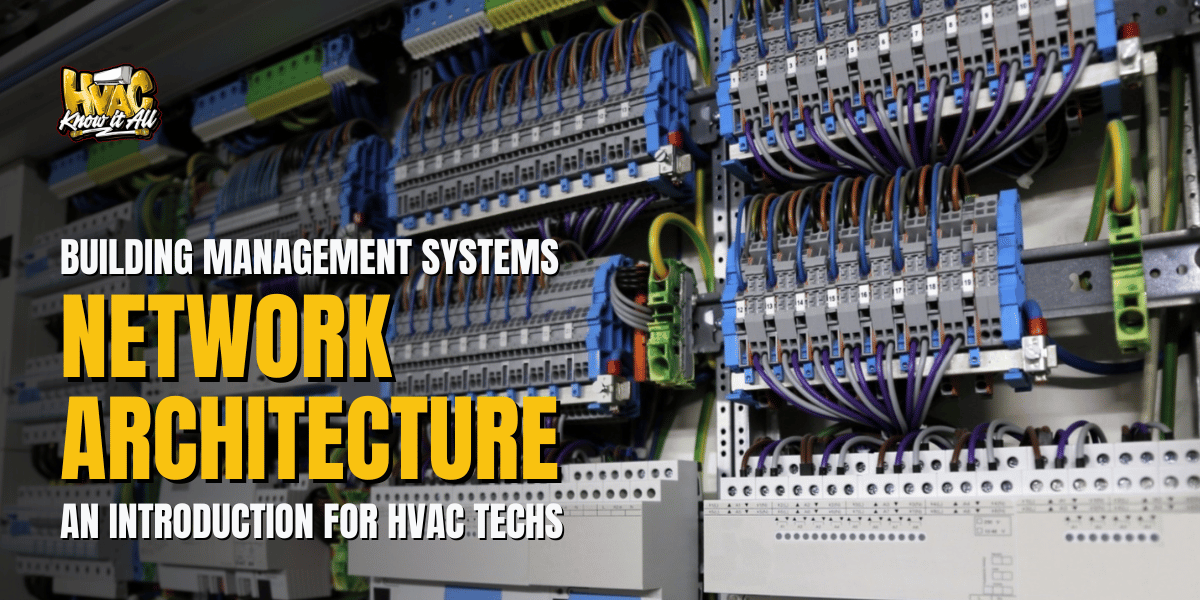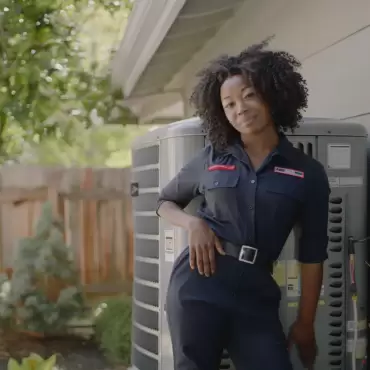You’re standing in front of a BMS workstation, watching as hundreds of data points update in real-time. Temperature readings from VAV boxes, valve positions from the chiller plant, fan speeds from air handlers—all flowing seamlessly across the screen. But when something goes wrong and those numbers stop updating, where do you even begin troubleshooting?
For many HVAC technicians, the network side of building automation feels like black magic. You’re comfortable with sensors, actuators, and control logic, but when someone mentions “MS/TP trunk” or “IP backbone,” your confidence wavers. The truth is, understanding BMS network architecture isn’t just for IT specialists—it’s becoming essential knowledge for modern HVAC technicians.
Let’s demystify how building control systems communicate, giving you the confidence to troubleshoot network issues and understand the digital highways that connect your mechanical systems.
The Three-Tier Architecture: Understanding the Hierarchy
Think of a BMS network like a corporate organization chart. Just as a company has executives, managers, and workers, a building automation system has three distinct levels, each with specific responsibilities.
Supervisory Level: The Executive Suite
At the top sits the supervisory level—the CEO of your building automation system. This layer includes:
- Servers and Workstations: The main computers running BMS software, storing historical data, and providing user interfaces
- Web Servers: Enabling remote access through browsers
- Database Servers: Storing trends, alarms, schedules, and configuration data
- Integration Servers: Connecting to enterprise systems and third-party applications
When you’re sitting at the BMS computer changing schedules or viewing graphics, you’re interacting with the supervisory level. This is where the big decisions happen—energy optimization algorithms, demand response strategies, and system-wide coordination.
Common Issues at This Level:
- Server crashes or software freezes
- Database corruption
- Network connectivity to the building level
- User authentication problems
Building Level: Middle Management
The building level controllers are your middle managers. Also called primary controllers or automation engines, these devices coordinate operations across multiple pieces of equipment. An automation engine might manage several air handlers, a central plant, or an entire floor of VAV boxes.
Key Characteristics:
- More powerful processors and memory than field controllers
- Advanced programming capabilities
- Multiple communication ports supporting different protocols
- Often include local I/O for critical equipment
These controllers can make complex decisions like determining optimal start times, coordinating economizer operation, or implementing demand limiting strategies.
Field Level: The Front Lines
Field controllers are your worker bees. A VAV controller manages one box, an AHU controller manages one air handler, and a chiller controller manages one chiller. They execute their specific control sequences based on commands from above and local sensor inputs.
Key Characteristics:
- Limited memory and processing power
- Focused on specific equipment or zones
- Can operate independently if communication is lost
- Direct physical connection to sensors and actuators
Understanding Communication Protocols: The Languages of BMS
If the three-tier architecture is the organizational structure, protocols are the languages these devices use to communicate. Let’s examine the three most common protocols you’ll encounter.
BACnet: The Universal Translator
Building Automation and Control Network (BACnet) was developed by ASHRAE specifically for building automation. Think of it as the “common tongue” of the BMS world.
How BACnet Works:
- Uses “objects” to represent data points (like Analog Input for temperature)
- Each object has standard properties (present value, status, alarms)
- Devices “speak” using standard services (read property, write property)
BACnet Variants You’ll See:
- BACnet IP: Runs over Ethernet networks, fast and IT-friendly
- BACnet MS/TP: Master-Slave/Token-Passing over RS-485, common for field devices
- BACnet/SC: Secure Connect, the newest variant with built-in cybersecurity
Practical BACnet Troubleshooting: When a BACnet device won’t communicate:
- Check physical connections (wires, polarity, termination resistors)
- Verify network settings (device ID, baud rate, MAC address)
- Use discovery tools to see if the device is visible on the network
- Check for duplicate device IDs (a common issue)
Modbus: The Industrial Veteran
Modbus is an older protocol but remains widely used, especially for integrating equipment like boilers, chillers, and VFDs. It’s simple but effective.
How Modbus Works:
- Uses “registers” to store data values
- Operates on a master-slave basis, where one device polls the others
- Minimal overhead, making it efficient for simple devices
Modbus Variants:
- Modbus RTU: Serial communication over RS-485
- Modbus TCP: Runs over Ethernet networks
Practical Modbus Troubleshooting:
- Verify register addresses (they vary by manufacturer)
- Check communication settings (baud rate, parity, stop bits)
- Ensure proper termination on RS-485 networks
- Look for address conflicts (each device needs a unique address)
LonWorks: The Comprehensive Alternative
LonWorks (or LON) is a comprehensive protocol developed by Echelon Corporation. Though less common in new installations, many existing buildings use LonWorks.
How LonWorks Functions:
- Uses “Standard Network Variable Types” (SNVTs) for data exchange
- Peer-to-peer architecture allows any device to communicate with any other
- Devices use “service pins” for addressing and configuration
Practical LON Troubleshooting:
- Check Neuron IDs and addresses
- Verify proper network termination
- Use network management tools to check device status
- Look for channel traffic issues (overloaded networks)
Physical Network Infrastructure: The Highways and Byways
Now that we understand the languages, let’s look at the physical infrastructure carrying these communications.
Ethernet: The Information Superhighway
Modern BMS systems increasingly use standard Ethernet for communication. This is the same technology used for office networks.
Key Characteristics:
- High speed (typically 100Mbps to 1Gbps)
- Star topology with switches and routers
- Can carry multiple protocols simultaneously (BACnet IP, Modbus TCP, etc.)
- Compatible with standard IT infrastructure
Common Applications:
- Supervisory level communication
- Building level controllers
- IP-based field controllers
- Integration with other building systems
RS-485: The Reliable Back Road
RS-485 is a robust serial communication standard used extensively in building automation, especially for field-level devices.
Key Characteristics:
- Multi-drop bus topology (devices connected in series)
- Typically runs at lower speeds (9600 to 76800 baud)
- Requires proper termination at each end
- Can span long distances (up to 4000 feet)
Common Applications:
- BACnet MS/TP networks
- Modbus RTU communication
- Connecting field controllers to building level controllers
For a deeper dive into the user interfaces that sit on top of these networks, check out our article on BMS User Interfaces.
Practical Network Troubleshooting for HVAC Techs
When network issues arise, follow this systematic approach:
- Determine the scope: Is it affecting one device, a group of devices, or the entire system?
- Check physical connections: Look for loose wires, improper terminations, or damaged cables.
- Verify power: Ensure all network devices have proper power.
- Check network settings: Verify addresses, baud rates, and other configuration parameters.
- Use diagnostic tools: Network analyzers can help identify communication errors.
- Isolate the problem: Disconnect segments of the network to locate the issue.
- Consult documentation: System architecture diagrams are invaluable for troubleshooting.
For more details on BMS control fundamentals that rely on these networks, read our BMS Control Fundamentals article.
Building Your Network Troubleshooting Toolkit
Every BMS technician should have these essential tools:
- Multimeter: To check power, continuity, and termination resistors
- Network Analyzer: To monitor network traffic and identify errors
- Protocol Analyzer: To decode and inspect messages on the network
- Laptop with BMS Software: To access and configure devices
- Network Documentation: Keep updated diagrams of your system architecture
Understanding BMS network architecture might seem daunting at first, but it follows logical principles that build on your existing HVAC knowledge. By mastering these concepts, you’ll be able to troubleshoot problems more effectively and provide more comprehensive service to your customers.
For those just starting with building automation systems, our BMS Basics article provides an excellent foundation for understanding the entire ecosystem.
Whether you require installation, repair, or maintenance, our technicians will assist you with top-quality service at any time of the day or night. Take comfort in knowing your indoor air quality is the best it can be with MOE heating & cooling services Ontario's solution for heating, air conditioning, and ventilation that’s cooler than the rest.
Contact us to schedule a visit. Our qualified team of technicians, are always ready to help you and guide you for heating and cooling issues. Weather you want to replace an old furnace or install a brand new air conditioner, we are here to help you. Our main office is at Kitchener but we can service most of Ontario's cities
Source link



